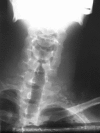A rare case of rib osteoblastoma: imaging features and review of literature
- PMID: 24348601
- PMCID: PMC3857978
- DOI: 10.5812/iranjradiol.7108
A rare case of rib osteoblastoma: imaging features and review of literature
Abstract
Osteoblastoma is a rare benign, but locally aggressive bone tumor with rare malignant transformation. It mostly affects the vertebral column and long bones. Radiographically, it is seen as an expansile, oval, sclerotic or lytic mass-like lesion with well-defined borders, although sometimes it may mimic a malignant tumor such as osteogenic sarcoma by its irregular borders. Herein, we report a case of osteoblastoma in a 22 year-old man with a long history of back and neck pain accompanied with neck stiffness. On the routine chest X-ray, the salient lesion appeared as an expansile, oval, sclerotic mass with well-defined borders and speckled calcification without any internal lucency and periosteal reaction, involving the posterolateral aspect of the first left thoracic rib, a rare anatomical site. Despite the unusual location, osteoblastoma should be considered in the differential diagnosis of a solitary rib lesion.
Keywords: Bone Neoplasms; Osteoblastoma; Osteoma, Osteoid; Ribs.
Figures







References
-
- Garcia RA, Inwards CY, Unni KK. Benign bone tumors--recent developments. Semin Diagn Pathol. 2011;28(1):73–85. - PubMed
Publication types
LinkOut - more resources
Full Text Sources
Other Literature Sources
